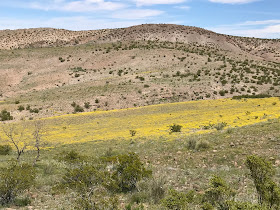Driving on I-10, off to south, in the distance, I could see the golden hillsides and just enough of the bright yellow blanket that covered flatlands to make me want to get a closer look. I knew these weren't poppies which is what I was headed for out in the Florida Mountains, but rather Arizona Bladderpod, which we already got a look at in great concentrations in the lowlands surrounding the Sierra de las Uvas.

After passing by a couple of more times, a kind of need grew. When I had chance to get out on Tuesday afternoon, I found myself driving out there by instinct.
I got to a place to park east of Chappel Peak and began walking toward it. The first fields of flowers appeared quickly. If I breathed deeply the heady scent penetrated to an infrequently stimulated place of joy in my brain. I kept walking on the gravel through creosote and flowers, and then to some low cliffs close to the base of the mountain. The rock was not from a cinder cone. It was the gray, older volcanics as in the Uvas across the highway. On the ground was a fantastic chunk of agate with veins of red ( carnelian? jasper?) running through it.



I didn't climb the peak, but continued to the northwest along its flanks to what appeared to be a volcanic dike that extended out from the little mountain like a bridge to the next hill over. Below me, the slopes and depressions were covered with flowers. On top other little gem-like species of wildflower caught my eye.





I circled around to the elongated ridge on the north side of the perfectly conical Chappel Peak, scrambling through the gravel to get to the top. I walked just a short ways on top before descending steeply through the hillsides covered in tall white flowers ( penstemon?) where the sound of thousands of bees busily collecting filled my ears.


To the north, the area called White Flat was now bright yellow with many acres covered in the ubiquitous bladderpod. Back down, I marched through the gravel and creosote until reaching a low saddle with the heaviest concentration of flowers, I had yet encountered.


 I thought about other Springs, when this miserably overgrazed ground would likely be bare dirt and gravel. Is the over utilization by livestock a factor that actually promotes these superblooms when they happen? I don't know.
I thought about other Springs, when this miserably overgrazed ground would likely be bare dirt and gravel. Is the over utilization by livestock a factor that actually promotes these superblooms when they happen? I don't know.
I continued to the east onto a cinder cone( one of the northernmost of the range), which had a cinder mining prospect trench dug in its side. On top, off to the northwest, I could see a black and red mountain stripped of the greens and grays of surface vegetation and soil, where large cinder excavations had taken place.

Ahead to the southeast between the hill and my truck, a coyote loped across the flats and gullies, taking time to look at me every 20 steps or so as it went. Another freight train rumbled by as I got to the truck, I hoped the engineer was enjoying the colorful landscape I had just spent the last few hours rambling through.

NOTE: Most of this hike is on New Mexico State Trust Lands where a recreation permit is required.















Very nice pictures. The white flowers you mentioned are White Tackstems, Calycoseris Whrightii.
ReplyDeleteThanks for the compliments and the ID of the daisy-like flower. I think one of the others is gray five eyes. The red one I don't know yet. I wish I had taken a close up of the very upright, long stemmed ones with small white flowers that seemed to only grow on the hillsides, so someone could help with identification on that one too.
ReplyDeleteThe red flowers are Sphaeralcea Ambigua , desert Globemallow . You are right the other flowers are Grays five eyes.
ReplyDeleteWow! The place looks beautiful for a walkabout. How do you get there from I10? It's near Providence Cone?
ReplyDeleteIt's 6 miles away from Providence Cone as the crow flies. It's very close to the railroad tracks. I used county road B-5. From the Corralitos Exit head to the south frontage and head west. Where the paved road heads left to the landfill, go straight on the dirt road for 8.5 miles. At the railroad tracks, cross over and head north. Chappel Peak is the very conical mountain immediately to the west. Unfortunately the wildflower display (super bloom) only seems to happen about once every seven or eight years now, but you never know.
ReplyDeleteThanks, Devon. I'm studying your book like a textbook to prepare for an early March 10 days or so of hiking with my friend in Organ Mts-Desert Peaks National Monument. Great book and blog.
ReplyDeleteThank you so much. If you run into any trouble out there, feel free to email: devfletch@msn.com
ReplyDelete